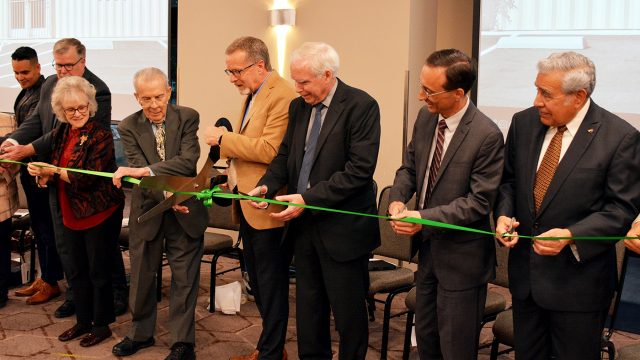The only safe place for Adventist young people was in Adventist schools.

Mahlon Ellsworth Olsen lost his job. The board of governors of Union College in Lincoln, Nebraska, terminated him in early 1923, after what General Conference treasurer J. L. Shaw described as “twenty-nine years of earnest, efficient, and faithful service.”1
What would he do next? And why was he fired?
The First 50 Years
Mahlon Olsen, son of Ole Andres Olsen, General Conference president from 1888 to 1897, had distinguished himself academically by becoming only the second Adventist to receive a Ph.D. His dissertation, Evolution of Biblical Prose, completed at the University of Michigan in 1909, was later condensed and published as a book by the denomination.
But Olsen’s accomplishments were hardly limited to academia, and preparation for his many years of distinguished service had been thorough and lifelong. Olsen recalled feeling very comfortable in Ellen White’s company when she visited his childhood homes in Green Bay, Wisconsin, and Christiana (Oslo), Norway, after his father moved there to lead the Adventist work in Scandinavia. Ellen and her husband, James, seemed so understanding of their needs that even favorite aunts and uncles “did not more completely win our hearts and affections than did James and Ellen White,” Olsen later wrote.2
When his father became General Conference president and moved his family back to the United States, Mahlon found a new and wonderful mentor in Goodloe Harper Bell, a professor of English. For the rest of his life Bell would share with Olsen the joys and insights of English and American literature, Wordsworth in particular, Bell’s favorite poet.
Between his graduation at Battle Creek College in 1894 and the turn of the century, Olsen worked as secretary to his father, still General Conference president, took advanced work in English at the University of Michigan, and wrote his earliest articles for the Adventist Review, the first of almost 300 articles that bore his byline in Adventist periodicals.
During the first decade of the new century, Olsen helped his physician brother, A. B. Olsen, in aggressive health work in England. Good Health, the magazine they launched in November 1901, reached 75,000 subscriptions by 1906. It became the widest circulated health journal in Great Britain, with copies placed in all the country’s major public libraries.
That year also saw publication of two books by the Olsen brothers: Good Health, dealing with physiology and related topics, and One Hundred Hygienic Food Recipes, a cookbook. Olsen also published his own book, Out-of-Doors. Its advocacy about walking and jogging for health is very much in vogue 100 years later. Olsen dedicated it to United States president Theodore Roosevelt, an outdoorsman he admired. His book achieved great popularity and was published again four years later in the United States.
After his return to the United States, Olsen’s teaching career began in earnest at Washington Foreign Mission Seminary, a new school for training missionaries near Washington, D.C. He simultaneously undertook the task of writing what would eventually appear, 16 years later, as A History of the Origin and Progress of Seventh-day Adventists.
Lydia Christensen, a pastor’s daughter from Denmark, was in Olsen’s classes because she wanted to learn English. She also took private lessons with him. They learned a lot more than English, enough to conclude that they could spend the rest of their lives learning together. They married in 1910. In five years’ time their family grew to five, including children Alice, Olan, and Yvonne.
In 1917 Olsen moved to Massachusetts to lead South Lancaster Academy, following in the footsteps of Bell, his mentor. The next year the school was renamed Lancaster Junior College (recently known as Atlantic Union College). Olsen emphasized practical training, such as hydrotherapy, carpentry, and sewing, and promoted missionary activities. He served until 1920, when he moved to Union College to lead the English Department. His abrupt termination in 1923 left him to speculate about the reason.
It turned out that the immediate issue that led to his firing was politics rather than ideology. His department’s other English teacher, Rochelle Philmon, apparently wished to run the department herself. A deeper cause, perhaps, lay in certain questions concerning the required reading for Olsen’s English classes.
From Fireside to HSI
Within Adventist education, Goodloe Harper Bell, as well as educators at Walla Walla College and Keene Academy, had made brief attempts to develop correspondence schools. Frederick Griggs’s Fireside Correspondence School, founded in Washington, D.C., in 1909, with W. E. Howell as principal, was still going. And whether it was church leaders’ memory of Olsen as a correspondence school promoter, or his solid academic credentials, or because J. L. Shaw, General Conference treasurer, was so convinced of his value, or simply because he was available, or because God had been fitting him all along for a spot that now needed filling, church leaders called Olsen to lead Fireside in 1923.
Olsen soon arrived in Washington and proceeded to engage vigorously. By the end of 1927 Fireside had grown to the largest enrollment of any school within the denomination. In 1930, the year Fireside was renamed Home Study Institute (HSI), enrollment was 2,711 students, representing more than 50 countries; new branches soon opened in Asia, India, Australia, South America, and Europe.
For Olsen, the only safe place for Adventist young people was in Adventist schools, and HSI was to help those who were “temporarily hindered from attending a resident college.”3 Other Adventist colleges were not always so accommodating. In 1942 Emmanuel Missionary College (EMC) requested a refund for George Vandeman so he could concentrate on his EMC studies. Nevertheless, Olsen’s 23 years at HSI built it into an elementary-through-college institution that served the entire world field.
Later Years (1946-1952)
Retirement at the age of 73 gave Olsen more time to write. His last major project, completed just weeks before his death, culminated in the publication of Much-Loved Books, an examination of literary works by Luther, Wordsworth, Thoreau, and Whittier, among others, including a chapter on James and Ellen White. The book advocated for Bible study, not merely as great literature, but as a power to transform lives.
Retirement also allowed Olsen to teach an upper-division literature class at Washington Missionary College (now Washington Adventist University). Students often dropped by to visit with their professor, an excellent conversationalist and a sympathetic listener.
In 1952 Olsen passed quietly into history. But his influence lives on through his work as health promoter, pioneer in Adventist higher education, church historian, prolific writer, and friend of students.
1 J. L. Shaw to M. E. Olsen, Apr. 18, 1923.
2 M. E. Olsen, Much-Loved Books (Washington, D.C.: Review and Herald Pub. Assn., 1952), pp. 56, 57.
3 M. E. Olsen, “An Alarming Situation: Are We Facing It Courageously?” Review and Herald, May 11, 1933, p. 19.
John Wesley Taylor V is an associate director of education for the General Conference in Silver Spring, Maryland, United States.








